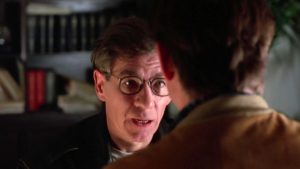Roger Spottiswide, director of such films as “Turner and Hooch” and “The 6th Day,” here directs a film of wide-sweeping proportions with his 1993 production “And the Band Played On.” The film, which outlines the struggle of understaffed scientists to fight the onset of the A.I.D.S epidemic – all while the world struggles to accept it – features a cast stacked with Hollywood talent, but, smartly, no show stealers. Based on the true story and book of the same name by journalist Randy Shilts (himself who died of the disease in 1993), the film is focused and highlights the horror, anxiety, and fear of A.I.D.S. as it made its way into American life.
The strength of the film is its ambivalence to moralize, focusing its runtime on those suffering from the disease and those seeking to fight it, mixing with it the time period of the late 1970s/1980s and the political climate it came crashing into.
The film opens in 1976 with a scientist named Don Francis (Matthew Modine) dealing with the Ebola fever threat in Africa before cutting to Copenhagen, and the first known death from a disease yet to be named A.I.D.S; a woman dies from Pneumocystis Pneumonia – a secondary disease that baffled doctors as it typically only affects people with immunosuppressive diseases – of which none could be noted in this victim.

And then there’s the crass terminology of the disease, calling it “Gay Cancer” and “Gay Related Immune Disorder” – after its quick spread among the gay communities of San Fransisco and New York City. Remarks Ian McKellen, playing a homosexual politician named Bill Kraus: “The only ones who want to read about gay people dying are other gay people and those who wish they’d all die.”
The film paints the landscape with a moving and doleful score by Carter Burwell (the “Twilight” series), as well as excellent casting. We have players such as Glenne Headley (“Mr. Holland’s Opus”), Anjelica Huston, and Richard Masur (as well as the aforementioned Modine) heading up the U.S. effort to stop the disease, with French actor Tchéky Karyo playing a passionate doctor heading up the French resistance.
The film’s gay community and victims are are represented with massive talent also, from McKellen, to B.D Wong (“Jurassic Park”), to Richard Gere, Donal Logue, Swoosie Kurtz, Phil Collins, and even Steve Martin, who plays into the movie in profound ways as the brother of one of the deceased.
The film’s acting is top notch; the actors aren’t playing themselves, as many movies with such a diverse cast falls victim to, but add to the film in unique ways. I was most impressed with Gere, McKellen, and Modine; the former who highlight different aspects of the fear and trepidation amidst the gay community, and the the latter who, while brash, has a fervor to fight the disease that flies in the face of an administration that quickly labels him as a problem.
The film also details the bureaucratic infighting between a pretentious scientist (Alan Alda) and the French who first discovered the virus, as well as the division and misinformation that turned the public against the disease. One hearing on potentially closing the San Fransisco bath houses shows this division well amongst the gay community, and hits home on the stigma A.I.D.S. fostered. This is interspersed with news bits of paramedic workers wearing masks to deliver mouth to mouth and EMS crews showing up to car crashes involving A.I.D.S victims in HAZMAT suits. Misinformation, bigotry, and panic lined the disease’s early days. It wasn’t until later, when the wealthy, blood transfusion patients, and even infants contracted the disease that A.I.D.S gained the serious treatment it deserved from the start.
“And the Band Played On” is an important film. It reviews a period in our recent history of an insidious disease that flew under the radar for much too long, as well as the politics and bureaucracy that hindered its discovery. It features excellent performances, an uncompromising message, and empathy and understanding on both sides. The film’s closing montage, scored by Elton John’s “The Last Song” highlights the scores of victims lost to the disease. While 2 hours and 21 minutes in length, the film watches fast, leaving in its wake an emotional portrayal of a disease that ravaged a nation, the bureaucracy that stood in its way, and the men and women devoted to stopping it at all costs.
– by Mark Ziobro